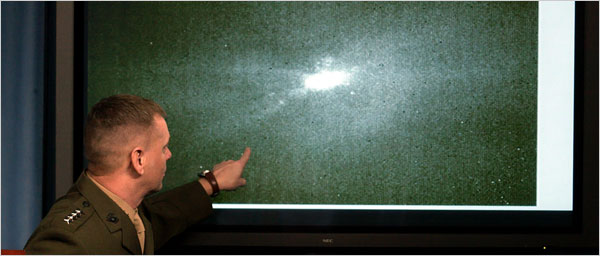
Videotape of the Navy mission to shoot down a dying spy satellite made available Thursday shows an interceptor missile ascending atop a bright trail of burning fuel, and then a flash, a fireball, a plume of vapor. A cloud of debris left little doubt that the missile had squarely hit its mark as the satellite spent its final days orbiting more than 130 miles above the Pacific Ocean.
A different kind of doubt still lingers, though, expressed by policy analysts, some politicians and scientists, and not a few foreign powers, especially China and Russia:
Should the people of the world be breathing a sigh of relief that the risk of a half-ton of frozen, toxic rocket fuel landing who knows where has passed? Or should they be worried about the latest display of the United States’ technical prowess, and see it as a thinly veiled test for a shadow antisatellite program?
How sure with no oxygen in space and no warhead on the missile that all the toxic rocket fuel was really burned up? Video here:
Defense Secretary Robert M. Gates, who personally gave the order to go ahead with the satellite shootdown Wednesday, told reporters in Hawaii on Thursday that he was prepared to share some details of the operation with China to ease its concerns that the debris might still prove dangerous. Adm. Timothy J. Keating, the commander of American forces in the Pacific, has reached out to several nations in the region to explain the mission, as well.
Addressing the diplomatic concerns, senior officials dismissed questions raised by the Chinese and the Russians, and echoed by some arms control analysts, about whether the episode was really a test of space weaponry. They pointed out that the missile used in the operation, the Navy’s SM-3 interceptor, was designed to counter a limited ballistic missile attack and had to be reprogrammed for this unexpected task, the likes of which the authorities are unlikely ever to face again.
In missile defense, an interceptor must find a red-hot enemy warhead as it arcs on a relatively short ballistic path, a task often described as “hitting a bullet with a bullet.” This time, the target — much larger then a warhead, almost the size of a school bus — was circling Earth predictably about 16 times a day.
It was still a bit of a long shot. The fuel tank that was the bull’s eye was only about 40 inches across.
And although the United States has hit test targets in space before — including a satellite destroyed in 1985 in a demonstration of an antisatellite weapon launched from a fighter jet — the successful demonstrations have been relatively few and far between.
What Wednesday’s successful strike in space conclusively proved was not infallibility but a robust and flexible military capability that can be cited by either side in what no doubt will be the ensuing debate.
The mission was conducted from Navy warships. So the United States can move this capability at will over three-quarters of the globe.
The missile-defense interceptor was converted to an antisatellite capability in little more than a month. No expensive research and development program. No battles with Congress over money. No starting from scratch on white boards in some laboratory.
This demonstration of military agility has to cause any adversary to pause.
NYTimes
No comments:
Post a Comment